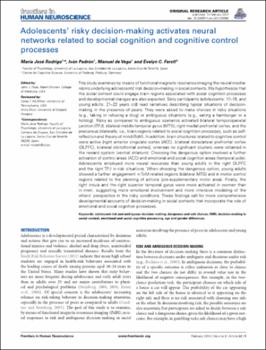Adolescents' risky decision-making activates neural networks related to social cognition and cognitive control processes
Fecha
2014Resumen
This study examines by means of functional magnetic resonance imaging the neural mechanisms underlying adolescents’ risk decision-making in social contexts.We hypothesize that
the social context could engage brain regions associated with social cognition processes
and developmental changes are also expected. Sixty participants (adolescents: 17–18, and
young adults: 21–22 years old) read narratives describing typical situations of decisionmaking in the presence of peers. They were asked to make choices in risky situations
(e.g., taking or refusing a drug) or ambiguous situations (e.g., eating a hamburger or a
hotdog). Risky as compared to ambiguous scenarios activated bilateral temporoparietal
junction (TPJ), bilateral middle temporal gyrus (MTG), right medial prefrontal cortex, and the
precuneus bilaterally; i.e., brain regions related to social cognition processes, such as selfreflection and theory of mind (ToM). In addition, brain structures related to cognitive control
were active [right anterior cingulate cortex (ACC), bilateral dorsolateral prefrontal cortex
(DLPFC), bilateral orbitofrontal cortex], whereas no significant clusters were obtained in
the reward system (ventral striatum). Choosing the dangerous option involved a further
activation of control areas (ACC) and emotional and social cognition areas (temporal pole).
Adolescents employed more neural resources than young adults in the right DLPFC
and the right TPJ in risk situations. When choosing the dangerous option, young adults
showed a further engagement in ToM related regions (bilateral MTG) and in motor control
regions related to the planning of actions (pre-supplementary motor area). Finally, the
right insula and the right superior temporal gyrus were more activated in women than
in men, suggesting more emotional involvement and more intensive modeling of the
others’ perspective in the risky conditions. These findings call for more comprehensive
developmental accounts of decision-making in social contexts that incorporate the role of
emotional and social cognition processes.





